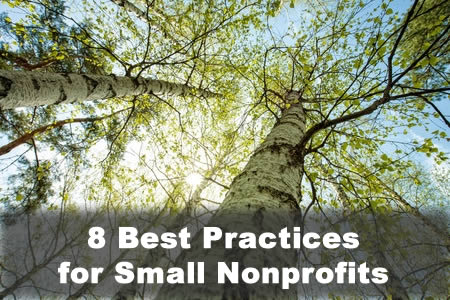There’s a misconception among some smaller nonprofits that “best practices” is a notion that only applies to the big guys. Wrong! Even in the beginning, a two staff, three volunteer (and the office cat) organization can benefit from adopting a higher standard of conduct.
Loosely collected under titles such as “guiding practices,” “principles and practices,” or “standards,” or other terms, these ideals are meant as guidelines for promoting moral, responsible, transparent and top-notch operations for all charities and their boards.
Why should you bother following best practices when your organization is very small?
Why would you want to do this? Your organization is very small. Surely this will take away from what you’re trying to achieve? Undoubtedly, embracing higher standards of conduct, especially in the early stages, takes some groundwork. But having “best practices” in place makes a strong statement to your staff, supporters and beneficiaries: this organization intends sticking around and growing, with clear benchmarks to guide it into the future.
Although there’s no single definition of “best practices,” a well-run nonprofit will recognize the value of general guidelines. The concepts differ from organization to organization and each individual state has different legal obligations for nonprofits which need to be adhered to.
Best practices for small nonprofits
- The single most important best practice for a nonprofit is complying with state and federal legal requirements. There are a host of free resources to help the cash-strapped, new nonprofit such as the Internal Revenue Service’s website. Other resources can be accessed on state attorney general’s websites or the websites of state charity officials.
For free online tools and resources for legal guidance, look for national, state and regional associations of nonprofit organizations. Low cost or pro-bono legal assistance can sometimes be found through your state Bar Association.
- Every charity should have a written code of ethics and all of the nonprofit’s people, from the founder to the youngest volunteer, should be familiar with this document and follow its principles. (Click here for an example.)
- There should be policies and procedures in place for some of the more common occurrences a nonprofit may face. Conflicts of interest, a “whistleblower” policy and procedures to safeguard the charity’s important records and documents should be covered with these policies.
- An organization needs plans to protect its tangible assets – property, data, financial records, all other content and material; as well as the intangible like integrity and reputation, against damage or loss. Should your charity have general liability insurance? What about directors’ liability coverage?
- Transparency is a vital, well-recognized and essential best practice to cultivate. Information about an organization’s governance, finances, operations, programs, and activities, should be widely available to the public. A yearly newsletter or a section of the nonprofit’s website can be devoted to this type of reporting. Don’t forget to highlight the effective outcomes and share the results of these successful methods.
- Every nonprofit, no matter how small, must have a governing body. Even in the mythical two staff, three volunteer (and the office cat) model; a board can be formed with two or three willing individuals – the cat doesn’t count. A charitable organization must have a governing body that is responsible for the mission and strategic route, annual budget and financial transactions, and other practices and policies.
- Vital for the continued health and growth of any nonprofit is good financial control and wise stewardship of charitable resources. For best practice, it’s important to keep complete, current, and accurate financial records and ensure strong financial controls are in place. The board should review the organization’s financial activities in a way that is suitable to the organization’s size and scale of operations.
- Any organization that raises funds from the public needs to do everything possible to build donor support and confidence. “Asks” and other communications, targeting donors and the public must clearly identify the charity and be exact and truthful. Donations should be acknowledged in accordance with IRS requirements.
Get help from your state assication
Many state associations offer online resources that organizations can use to evaluate their current standards because self-regulation begins with good governance. You can find your state association here.
If your small nonprofit is struggling with the “best practices” issue, reaching these levels may take some time. But the process of working towards these standards will strengthen your organization and its ability to serve the community. The key here is, in some small way, begin today!

